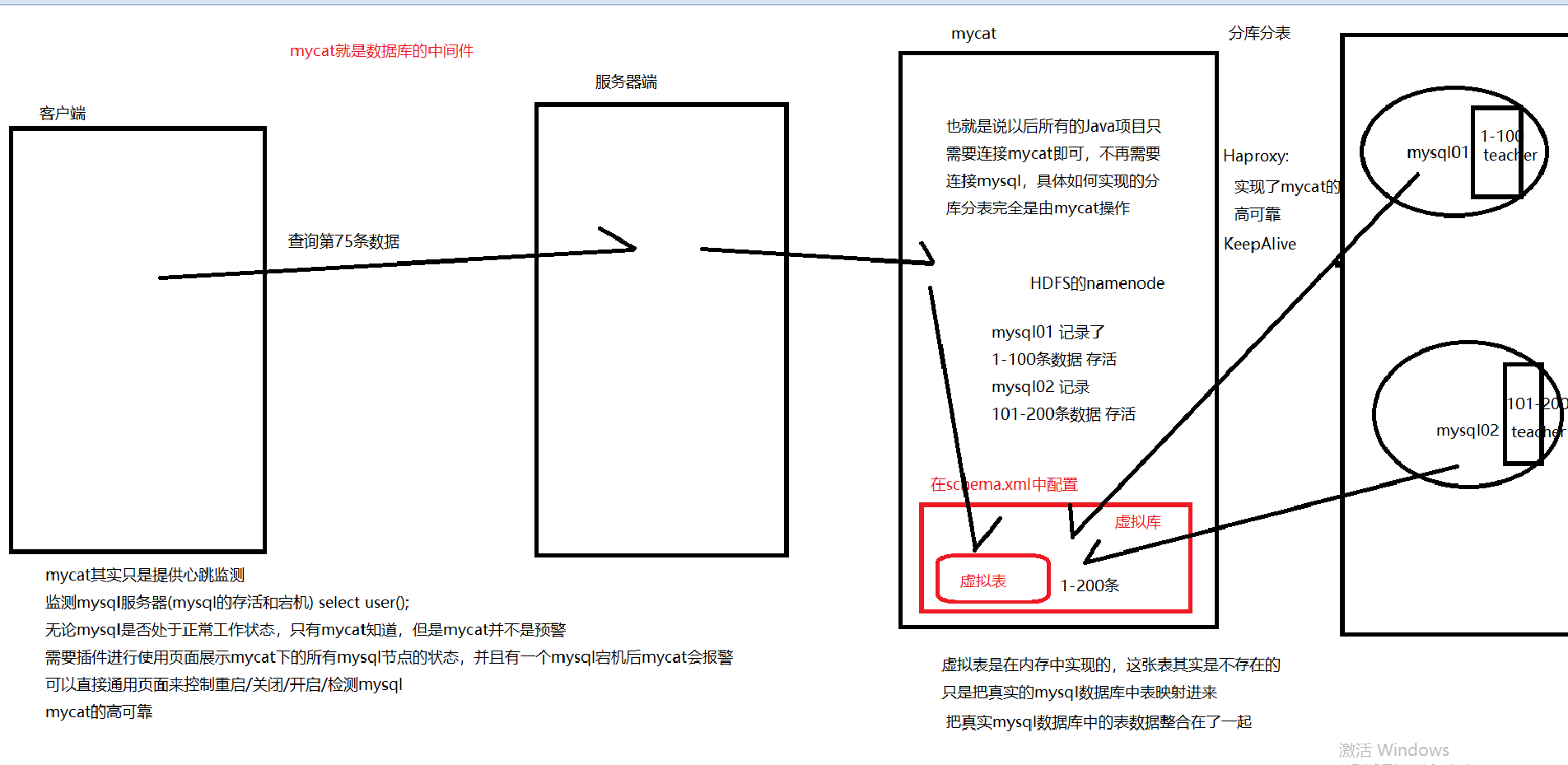Linux 如何配置mycat? 3.配置mycat 3.1.规定linux的用户名和全名不能叫mycat!!!否则mycat会不生效(原因是影响整个linux系统的环境变量导致mycat的配置环境变量没有生效) 3.2.vim /etc/sysconfig/network也不能叫mycat 3.3.mycat使用的是Java语言编写-->所以必须要在linux上配置jdk(要求jdk必须为64位,因为mycat是在64位的jdk8上进行编译的) 3.4.配置jdk 3.5.使用xftp把mycat的压缩包上传到linux服务器上 3.6.解压mycat压缩包 tar -zxvf xxxxx 3.7.配置mycat的环境变量 vim /etc/profile JAVA_HOME=/home/apps/jdkxxx MACAT_HOME=/home/apps/mycat PATH=$PATH:$JAVA_HOME/bin:$MACAT_HOME/bin source /etc/profile 3.8.启动mycat 进入mycat的bin目录 // ./mycat console // mycat start 在任意的位置直接使用 mycat console console | start | stop | restart | status | dump 启动mycat: mycat console 类似于IDEA中控制台,mycat会把日志打印出来 mycat start 就是正常启动 一般情况下推荐使用console启动 一旦启动mycat就关不掉,kill -9关不掉 除非重启或者关机 看到以下信息说明启动成功: jvm 1 | MyCAT Server startup successfully. see logs in logs/mycat.log 3.8.9关闭的方法 直接reboot。 就是关不掉 直接reboot。 4.mycat的三个核心配置文件 所有的读写分离/分库分表都必须要在这三个配置文件完成 // server.xml rule.xml schema.xml mycat的conf目录
二、分库分表的配置。 server.xml、 rule.xml 、(打酱油的。) scheam.xml 实现了读写分离和分库分表的具体配置。
4.mycat的三个核心配置文件 所有的读写分离/分库分表都必须要在这三个配置文件完成 // server.xml rule.xml schema.xml mycat的conf目录 //1. server.xml: 配置了mycat的用户(账号:root 密码:root) --> 账号和密码可以根据情况随意更改 相当于mysql的用户(账号:root 密码:root) mycat也是可以直接使用数据库连接软件进行连接的 //2. rule.xml: mycat的规则 //3. schema.xml: 实现了读写分离和分库分表的具体配置 其实mycat也可以看成是一个数据库,只是这个数据库是虚拟的,把真实的mysql数据中的表数据/* 映射 */进了虚拟库中,使用Java项目连接的时候只需要连接mycat即可,不再需要连接mysql 注意报错: Caused by: io.mycat.config.util.ConfigException: Illegal table conf : table [ MYCAT_STUDENT ] rule function [ mod-long ] partition size : 3 > table datanode size : 2, please make sure table datanode size = function partition 启动成功后可以直接使用数据库连接工具连接mycat mycat的dbType配置的是什么数据库,就使用这一种数据库进行连接即可 mycat有两个端口号: 9066:管理端口号(管理mycat使用的) 8066:通讯端口号(连接端口号)
1.rule.xml
<?xml version="1.0" encoding="UTF-8"?> <!-- - - Licensed under the Apache License, Version 2.0 (the "License"); - you may not use this file except in compliance with the License. - You may obtain a copy of the License at - - http://www.apache.org/licenses/LICENSE-2.0 - - Unless required by applicable law or agreed to in writing, software - distributed under the License is distributed on an "AS IS" BASIS, - WITHOUT WARRANTIES OR CONDITIONS OF ANY KIND, either express or implied. - See the License for the specific language governing permissions and - limitations under the License. --> <!DOCTYPE mycat:rule SYSTEM "rule.dtd"> <mycat:rule xmlns:mycat="http://io.mycat/"> <!-- 所有的规则配置一个tableRule对应一个function,如果需要进行配置必须要配置一对,不能单独配置一个(如果单独配置了一个的情况下,mycat启动的时候会直接报错) 一共有十种规则: mod-long:(轮询) mysql01 mysql数据库 teach student mysql02 mysql数据库 teach student 当客户端发送请求===插入数据===》mycat===请求mysql===》会把第一条数据插入进mysql01, 会把第二条数据插入进mysql02 依次循环 --> <tableRule name="mod-long"> <rule> <columns>id</columns> <algorithm>mod-long</algorithm> </rule> </tableRule> <function name="mod-long" class="io.mycat.route.function.PartitionByMod"> <!-- 代表了datanode的节点数量 如果只有两台datanode就必须要写2 --> <property name="count">2</property> </function> </mycat:rule>
2.server.xml
<?xml version="1.0" encoding="UTF-8"?> <!-- - - Licensed under the Apache License, Version 2.0 (the "License"); - you may not use this file except in compliance with the License. - You may obtain a copy of the License at - - http://www.apache.org/licenses/LICENSE-2.0 - - Unless required by applicable law or agreed to in writing, software - distributed under the License is distributed on an "AS IS" BASIS, - WITHOUT WARRANTIES OR CONDITIONS OF ANY KIND, either express or implied. - See the License for the specific language governing permissions and - limitations under the License. --> <!DOCTYPE mycat:server SYSTEM "server.dtd"> <mycat:server xmlns:mycat="http://io.mycat/"> <system> <property name="nonePasswordLogin">0</property> <!-- 0为需要密码登陆、1为不需要密码登陆 ,默认为0,设置为1则需要指定默认账户--> <property name="useHandshakeV10">1</property> <property name="useSqlStat">0</property> <!-- 1为开启实时统计、0为关闭 --> <property name="useGlobleTableCheck">0</property> <!-- 1为开启全加班一致性检测、0为关闭 --> <property name="sequnceHandlerType">2</property> <!--<property name="sequnceHandlerPattern">(?:(s*nexts+values+fors*MYCATSEQ_(w+))(,|)|s)*)+</property>--> <!--必须带有MYCATSEQ_或者 mycatseq_进入序列匹配流程 注意MYCATSEQ_有空格的情况--> <property name="sequnceHandlerPattern">(?:(s*nexts+values+fors*MYCATSEQ_(w+))(,|)|s)*)+</property> <property name="subqueryRelationshipCheck">false</property> <!-- 子查询中存在关联查询的情况下,检查关联字段中是否有分片字段 .默认 false --> <!-- <property name="useCompression">1</property>--> <!--1为开启mysql压缩协议--> <!-- <property name="fakeMySQLVersion">5.6.20</property>--> <!--设置模拟的MySQL版本号--> <!-- <property name="processorBufferChunk">40960</property> --> <!-- <property name="processors">1</property> <property name="processorExecutor">32</property> --> <!--默认为type 0: DirectByteBufferPool | type 1 ByteBufferArena | type 2 NettyBufferPool --> <property name="processorBufferPoolType">0</property> <!--默认是65535 64K 用于sql解析时最大文本长度 --> <!--<property name="maxStringLiteralLength">65535</property>--> <!--<property name="sequnceHandlerType">0</property>--> <!--<property name="backSocketNoDelay">1</property>--> <!--<property name="frontSocketNoDelay">1</property>--> <!--<property name="processorExecutor">16</property>--> <!-- <property name="serverPort">8066</property> <property name="managerPort">9066</property> <property name="idleTimeout">300000</property> <property name="bindIp">0.0.0.0</property> <property name="frontWriteQueueSize">4096</property> <property name="processors">32</property> --> <!--分布式事务开关,0为不过滤分布式事务,1为过滤分布式事务(如果分布式事务内只涉及全局表,则不过滤),2为不过滤分布式事务,但是记录分布式事务日志--> <property name="handleDistributedTransactions">0</property> <!-- off heap for merge/order/group/limit 1开启 0关闭 --> <property name="useOffHeapForMerge">0</property> <!-- 单位为m --> <property name="memoryPageSize">64k</property> <!-- 单位为k --> <property name="spillsFileBufferSize">1k</property> <property name="useStreamOutput">0</property> <!-- 单位为m --> <property name="systemReserveMemorySize">384m</property> <!--是否采用zookeeper协调切换 --> <property name="useZKSwitch">false</property> <!-- XA Recovery Log日志路径 --> <!--<property name="XARecoveryLogBaseDir">./</property>--> <!-- XA Recovery Log日志名称 --> <!--<property name="XARecoveryLogBaseName">tmlog</property>--> <!--如果为 true的话 严格遵守隔离级别,不会在仅仅只有select语句的时候在事务中切换连接--> <property name="strictTxIsolation">false</property> <property name="useZKSwitch">true</property> </system> <!-- 从system标签开始到结束中的内容配置了 连接 最大连接数 最小连接数 连接超时时间 隔离机制 事务切换.... 相当于在mybatis中配置数据库的最大最小连接数 连接超时时间 --> <!-- 全局SQL防火墙设置 --> <!--白名单可以使用通配符%或着*--> <!--例如<host host="127.0.0.*" user="root"/>--> <!--例如<host host="127.0.*" user="root"/>--> <!--例如<host host="127.*" user="root"/>--> <!--例如<host host="1*7.*" user="root"/>--> <!--这些配置情况下对于127.0.0.1都能以root账户登录--> <!-- <firewall> <whitehost> <host host="1*7.0.0.*" user="root"/> </whitehost> <blacklist check="false"> </blacklist> </firewall> --> <!-- 整个user标签中就是配置了mycat的账号和密码 name===》就是mycat的账号 defaultAccount====》表示该账号为管理员账号,而且只能出现一次 property:属性标签 password===》就是name的密码 无论是账号还是密码都可以随意定制,开心就好!!! readOnly:只读(该账号只能查询数据,不能写入数据) schemas:指向的是mycat的数据库(mycat的虚拟库!!!这个库并不是真实存在的,是需要通过mysql的数据库进行映射的),一个mycat中可以有多个schema 隐藏mysql的真实库的名字 连接mysql: jdbc:mysql:localhost:3306/数据库名 连接mycat: jdbc:mysql:ip地址:端口号/mycat的虚拟库名 schemas中的配置和mysql的数据库可以一样,也可以不一样 --> <user name="root" defaultAccount="true"> <property name="password">123456</property> <property name="schemas">TEACH</property> </user> </mycat:server>
3.scheam.xml
<?xml version="1.0"?> <!DOCTYPE mycat:schema SYSTEM "schema.dtd"> <mycat:schema xmlns:mycat="http://io.mycat/"> <!-- !!!schema标签的name属性值必须要和server.xml中的schames保持一致!!! schema就类似于mysql的数据库 checkSQLschema:检查SQL语句是否错误(select * from user wher id = 1) 默认值为false,不需要改为true,把对SQL语句的检查交给mysql处理 sqlMaxLimit:最大执行SQL语句的数量 一次性可以执行多少条SQL语句 在schame标签中有table标签,这个标签就是定义了mycat中的表 类似于mysql数据库中的表 和mysql中的表名可以重复也可以不一致 dataNode:数据节点 在HDFS中存放数据 在mycat中映射的就是真实mysql数据库(可以有多个,也可以只有一个),名字可以随意起 今天的目标是实现分库分表,需要用到两台mysql数据库,所以只需要配置dn1和dn2 rule:配置规则 配置一定要和rule.xml中保持一致 --> <schema name="TEACH" checkSQLschema="false" sqlMaxLimit="100"> <!-- auto sharding by id (long) --> <table name="mycat_student" dataNode="dn1,dn2" rule="mod-long" /> </schema> <!-- datanode标签对应的是table标签中的datanode属性 也就是说datanode属性值必须要和dataNode的标签name属性值保值一致 dn1:代表了mysql01服务器==》mysql数据库 dn2:代表了mysql02服务器==》mysql数据库 dataHost:才是真正的配置了分库分表和读写分离的核心配置 database:映射的是真实mysql的数据库名 --> <dataNode name="dn1" dataHost="localhost1" database="mysql01" /> <dataNode name="dn2" dataHost="localhost2" database="mysql02" /> <!-- dataHost标签必须要和dataNode标签中的dataHost属性保持一致 如果dataHost属性名重复了,映射的是同一个dataHost 每一个dataHost标签就是一个真实的mysql数据库 maxCon:最大连接数 minCon:最小连接数 homework2: 把balance,writeType,switchType弄明白,并且用自己的语言描述每个值代表什么意思,记录电子文档 balance:负载均衡 writeType:写入的类型(读写分离使用) switchType:转换的类型(读写分离所使用的数据) dbType:数据库的类型(在最早的版本mycat只支持mysql一种数据库,后来发展支持很多种数据库) dbDriver:数据库驱动(使用本地驱动,使用的是mycat所提供的驱动) slaveThreshold: master:主节点 slave:从节点 threshold:入口 --> <dataHost name="localhost1" maxCon="1000" minCon="10" balance="0" writeType="0" dbType="mysql" dbDriver="native" switchType="1" slaveThreshold="100"> <!-- heartbeat:心跳 mycat一直在监视mysql的user表(心跳),如果一旦发现mysql的user不再有心跳,就会认为这一台mysql处于宕机状态,也就不会再向这一台mysql进行做增删改查的操作 --> <heartbeat>select user()</heartbeat> <!-- writeHost:标签是该台mysql数据库为读和写的数据库 readHost:标签是该台mysql数据库为读的数据库 writeHost如果单独存在,标识该台mysql数据库为读和写的操作 如果一旦和readHost一起使用,writeHost就只能做些的操作,所有的读操作都使用readHost完成 readHost必须要配置在writeHost的内容,不允许单独存在 host:属性只是标识了该台数据库的操作的内容,可以随意定义 url:数据库的url jdbc:mysql://localhost:3306 !!!!!如果配置了两个writeHost,那么host的值就必须不能重复!!!!! --> <writeHost host="write01" url="192.168.132.150:3306" user="root" password="root" /> </dataHost> <dataHost name="localhost2" maxCon="1000" minCon="10" balance="0" writeType="0" dbType="mysql" dbDriver="native" switchType="1" slaveThreshold="100"> <heartbeat>select user()</heartbeat> <writeHost host="write02" url="192.168.132.148:3306" user="root" password="root" /> </dataHost> <!-- mycat中所映射的真实mysql的表必须要mycat所声明的table的名字保持一致 也就是说mycat的表名必须要和mysql的表名一模一样,否则映射不到 --> </mycat:schema>
